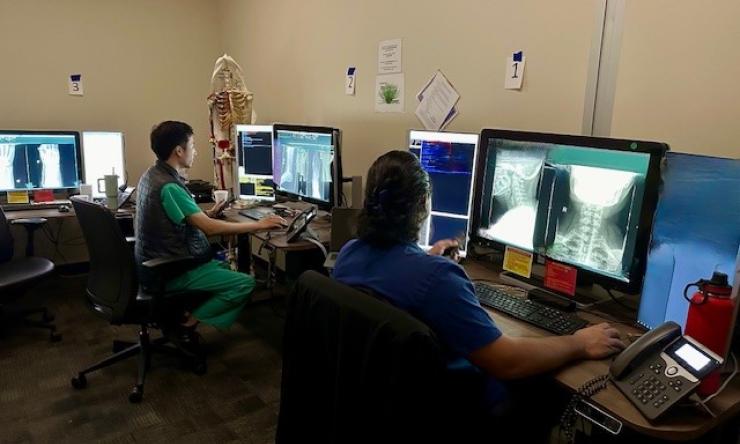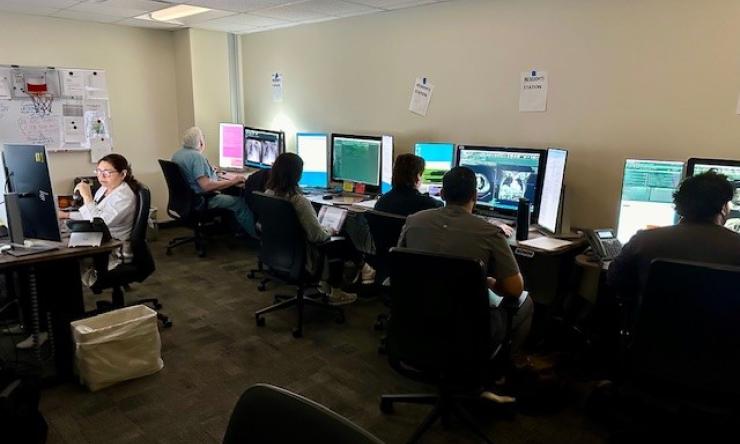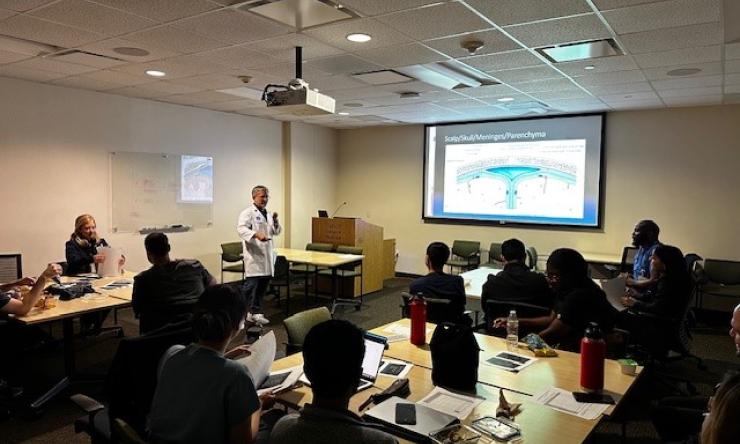
Residents working while on rotation at Ben Taub.

Radiology Residents and faculty working at Ben Taub.
Clinical Rotations
First-Year Rotations
Eight months of the first year are spent within Harris Health (at Ben Taub Hospital and Smith Clinic). Residents will spend a month each in body imaging, fluoroscopy, breast imaging, musculoskeletal radiology, chest imaging, neuroradiology, and ultrasound. Residents also gain early, supervised autonomy on their one-month rotation reading studies from the Ben Taub Hospital Emergency Center. As one of two level I trauma centers in the Texas Medical Center, the BTH EC allows residents to read a large volume of studies while learning the practical skills of radiology. This early level of supervised autonomy puts Baylor first-year residents well ahead of their counterparts at other programs in terms of efficiency, speed, and fund of knowledge. Two months will be spent at the MEDVAMC in Ultrasound and Nuclear Medicine. Residents have early exposure to pediatric radiology at Texas Children’s Hospital on their one-month rotation. Residents also gain additional nuclear medicine experience at Baylor St. Luke’s Medical Center/the McNair Campus on their one-month rotation.
The first-year rotations and didactics at Baylor are structured to give residents a strong foundation in the fundamentals of radiology. First-year residents have their own, separate curriculum. These noon conferences are interactive and centered on team-based learning. This approach allows the curriculum to be tailored to an R1 level of training and maximizes the learning potential of first-year residents.
R1 Rotations:
- Ben Taub Body
- Ben Taub Ultrasound
- Ben Taub Neuroradiology (CT)
- Ben Taub Chest
- Ben Taub MSK
- Ben Taub Emergency Center
- Smith Clinic Fluoroscopy
- Smith Clinic Breast Imaging
- St. Luke’s Nuclear Medicine
- Texas Children’s Pediatrics
- VA Nuclear Medicine
- VA Ultrasound
Second-Year Rotations
With a strong foundation in the fundamentals of radiology, second-year residents enter their most rigorous year of training.
Residents rotate through vascular and interventional radiology at Ben Taub for three consecutive months. The first two months are dedicated to body cases and the last month is spent on neurointerventional radiology. Residents are given graduated levels of autonomy and responsibility as they build their procedural skills over the next three months. As there is no VIR fellowship program at Baylor, the residents are treated as fellows with regards to responsibilities and procedural caseload. Consequently, residents accumulate substantial experience as primary operators on a large variety of cases.
Residents rotate at Smith Clinic for a second month of Breast Imaging, which includes interpreting diagnostic exams (mammograms, ultrasounds, and MRIs) as well as performing a variety of procedures, including ultrasound, MRI and stereotactic-guided biopsies. Residents spend one month at Ben Taub on a Neuroradiology MRI rotation, and an additional month at Ben Taub on a Neuroradiology MRI rotation, and an additional month at Ben Taub on Chest, MSK, or Body. Two months are spent on Ben Taub Night Float (which is split with a co-resident).
Two months are spent at the VAMC on Nuclear Medicine and MRI rotations. One month is dedicated to TCH pediatric radiology, and an additional month is spent at MD Anderson on the Thoracic Imaging rotation.
R2 Rotations:
- Ben Taub IR 1
- Ben Taub IR 2
- Ben Taub IR 3
- Ben Taub Night Float 1
- Ben Taub Night Float 2
- Ben Taub Neuroradiology (MRI)
- Ben Taub Chest, MSK, Body or Floater
- Smith Clinic Breast Imaging
- MD Anderson Chest
- Texas Children’s Pediatrics
- VA Nuclear Medicine
- VA Body/MSK MRI
Third-Year Rotations
As residents transition to their third year, with the ABR Core Exam, fellowship interviews, and match in their near future, rotations are well-balanced to allow residents to continue learning the day-to-day skills of radiology yet provide enough time for independent study. Daily conferences are tailored to meet the expectations of the Core Exam. One of the many benefits of being in the Texas Medical Center is the number of partner institutions Baylor residents draw from for board reviews. Through collaboration with UT Houston Radiology and Methodist Radiology, residents from all programs attend multiple reviews given by leaders in each subspecialty of radiology.
Six months of R3 year are spent within Harris Health. As an upper level resident at BTH, you have the opportunity to interact with colleagues from other specialties while attending, and frequently presenting at, multidisciplinary conferences.
Two months are also spent at the Baylor St Luke Medical Center/McNair Campus, one in Body Imaging and the second in Cardiac Imaging. The Baylor St Luke’s advanced cardiac imaging department works in conjunction with the Texas Heart Institute, one of the largest centers and pioneers of cardiac care in the world. The resident will be trained in the intricacies of cardiac CT and MRI by dedicated cardiac imagers. The body rotation is a great opportunity for residents to get experience with interpreting transplant imaging.
One month is spent at MDACC rotating through the nuclear medicine department and increasing exposure to PET/CTs. Two months are spent at TCH, and an additional month in Neuroradiology or Body/MSK MRI is spent at the MEDVAMC.
R3 Rotations:
- Ben Taub Night Float
- Ben Taub Body/Swing
- Ben Taub MSK
- Ben Taub Chest
- Ben Taub/Smith Clinic Body
- Ben Taub Chest, MSK or Floater
- MD Anderson PET/CT
- St. Luke’s Body
- St. Luke’s Cardiac Imaging
- TCH Pediatrics
- TCH Pediatrics
- VA Neuroradiology or Body/MSK MRI
Fourth-Year Rotations
With the ABR Core exam and fellowship match behind them, fourth-year residents have the opportunity to build an individualized curriculum to suit their needs during their final year of residency. The curriculum allows several months of electives spread across Texas Children’s Hospital, the VA Medical Center, BTH/Smith Clinic, MD Anderson, and Baylor St. Luke’s Medical Center.
Recognizing that there is more to radiology than “dictating in a vacuum,” fourth-year residents also have the opportunity to present at multidisciplinary conferences, sit in on quality and safety meetings and to teach the lower-level residents on both rotations and in conferences. At Baylor, we strive to produce outstanding radiologists who are educators and leaders in their field.
R4 Rotations:
- Ben Taub Night Float
- Ben Taub Nuclear Medicine
- Smith Clinic Breast Imaging
- Ben Taub/Smith Elective
- Ben Taub/Smith Elective
- Ben Taub/Smith Elective
- Ben Taub/Smith Elective
- VA Elective
- Texas Children’s Pediatrics
- St. Luke’s Body
- MD Anderson Elective
- Elective at Ben Taub, VA, St. Luke's or MD Anderson
Call, Nights, and Moonlighting
As an R1, you don't have any true call shifts, but will split weekend readout of inpatient plain films amongst the 12 residents in the class. After reading the plain films on a Saturday or Sunday morning, you are done for the day and have the rest of the day off. The R1 residents do not work nights.
At Ben Taub, the R2 residents taking neuroradiology call on the weekends, and later in the academic year, also start to pick up body call shifts. These provide a great way to solidify the knowledge built over R1/R2 year and to gain experience that will assist with the two months of nights at Ben Taub. The nights rotation at Ben Taub is split with a co-resident. Additionally, during their month of Chest radiology at MDACC, one week is spent on MDACC nights.
R3s split body call on the weekends during the first half of the academic year. R3s also have one month of nights at Ben Taub. Starting in January, the R3s no longer have weekend call, and have weekends and nights off throughout the spring to study for the Core exam.
R4 residents do not have weekend call. The R4s have one month of nights during the spring at Ben Taub.
While rotating at Texas Children's Hospital, R3s and R4s may be assigned to one week of nights.
Interventional Radiology (IR) call: The R2 residents who are on their 3-month IR block only take IR call during their 2nd and 3rd months of IR. Outside of the IR-block, residents do not take IR call (unless they are an ESIR resident and will take IR call their R4 year).
Moonlighting opportunities are available as early as R1 year (contrast coverage at our outpatient facility, the Smith Clinic, and at Baylor St. Luke's Medical Center/McNair Campus). More senior residents are able to moonlight at Ben Taub, Texas Children's Hospital, and Baylor St. Luke's Medical Center/McNair Campus.
Research
While there are no research requirements for our residency (other than a senior QI project requirement by ACGME), there are numerous research opportunities available to residents interested in pursuing research projects(s). Our residents routinely produce publications in prestigious journals and present at local, national, and international conferences. Residents interested in academic careers are able to network and participate in research with the many internationally renowned radiologists and other physicians in the Texas Medical Center.
Educational Resources
In addition to the wealth of free resources available through the Texas Medical Center Library, all residents have access to STATdx and RADPrimer. These web-based tools help residents increase their knowledge, accuracy and confidence, and are a valuable resource when preparing for the ABR Core Examination.

R1 residents at their weekly Body TBL conference with Dr. Farinas.

R1 residents at their weekly Neuro TBL conference with Dr. Diaz.
Didactics
All residents attend a daily noon conference. Conferences for PGY-3 through PGY-5 (R2 through R4) residents are generally case-based. The PGY-2 (R1) residents attend a special year-long conference series designed to teach the fundamentals of radiology, including the physics of radiology and TBL (team-based learning), which occurs twice a week (body and neuro). The R1s are split into groups and participate in a flipped-classroom style of learning where they can apply the material and get comfortable with the basics.
Residents also benefit from a monthly journal club, radiology-pathology conference, PBL/SBP (practice-based learning/systems-based practice) conference, TBL (team-based learning) sessions, and additional conferences on topics in business-in-medicine, leadership in radiology, and artificial intelligence. While lectures are generally given in person, most conferences have a virtual option. The radiology department will frequently invite experts from both the Texas Medical Center and around the country to give lectures tailored towards our residents.
An additional advantage of training in the Texas Medical Center is access to extensive daily conferences at Ben Taub, MDACC, BSLMC/McNair Campus, and TCH, as well as other institutions. These conferences include tumor boards, interesting case conferences, multidisciplinary conferences, and research conferences. Periodically, leaders within the Texas Medical Center will give conferences on business in medicine, medico-legal topics, and leadership, among other topics.








